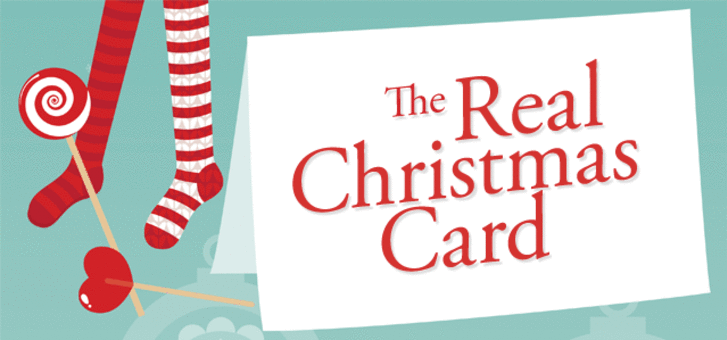Hallmark estimates that the number of Christmas cards sent annually in the US alone is around 1.5 billion. That translates to roughly five cards per person. While the numbers are lower in Australia and New Zealand, their popularity is little different.
Christmas communications
We have a tremendous selection when it comes to the Christmas cards we send, and no doubt you’ve received many of them. There is the corporate bulk Christmas card when you care enough to send a one-size-fits-all, pre-printed sentiment with photocopied signature.
Almost as bad is the Christmas letter. These atrocities would work if only their creators would stick to tasteful sound bites highlighting only a handful of accomplishments. Instead, they are produced by people who share every detail of their lives of the past 364 days and mail it to you to keep in your personal library.
Then, of course, we have the family photo option. These are always pleasant, but the process is a nightmare. I have taken Christmas photos that strove to use every man, woman, child, pet and plant in my house. I’m grateful just to have survived that experience.
The Nativity
Much Christmas card imagery comes from the Bible book of Luke, chapter 2—the story of the shepherds who came to worship Jesus: “So they hurried off and found Mary and Joseph, and the baby, who was lying in the manger. When they had seen him, they spread the word concerning what had been told them about this child, and all who heard it were amazed at what the shepherds said to them. But Mary treasured up all these things and pondered them in her heart. The shepherds returned, glorifying and praising God for all the things they had heard and seen, which were just as they had been told” (verses 16–20).
But there’s another image of what is going on that we seldom see displayed.
Picture a scene set in outer space. On the cover of the card is a woman about to give birth. Her mouth is open, crying out—not with a Christmas carol, but with the pain of birth. And the best part? When you open the card, the scene unfolds so that you see a huge red dragon waiting right in front of her, its mouth open, ready to devour the child the moment it is born.
Would your grandparents be offended by this Christmas card? Would it scare your children? Yet this is how the prophetic book of Revelation pictures the birth of Jesus:
“She was pregnant and cried out in pain as she was about to give birth. Then another sign appeared in heaven: an enormous red dragon with seven heads and ten horns and seven crowns on its heads. Its tail swept a third of the stars out of the sky and flung them to the earth. The dragon stood in front of the woman who was about to give birth, so that it might devour her child the moment he was born” (Revelation 12:2–4).
What It Means
From the vantage point of heaven, the birth of Jesus was an attack on the kingdom of evil. The dragon, representing the devil, hoped to snuff out the Saviour’s life (you can read the story in Matthew 2) shortly after He was born. Author Philip Yancey puts it this way, “In heaven the Great Invasion had begun, a daring raid by the ruler of the forces of good into the universe’s seat of evil.”
Jesus was entering into human history in human form to die a death on behalf of humankind so that He could save us from the sin and evil that separates us from God and restore us for eternity. The message of Christmas is that God has not left us on a dark planet all on our own but came to connect with us and set us free. And it’s a salvation we still need.
Saved From Guilt
Dragons prowl our planet today in the form of addictions, violence, hatred and selfishness. Turn on the news, and you’ll see red dragons at work hurting others and themselves. You’ve possibly wrestled with a few such dragons in your own life.
The sad reality is that all of us have dragons from which we need deliverance. The Bible is clear that selfishness is our natural default and that “the heart is deceitful above all things and beyond cure” (Jeremiah 17:9).
Thankfully, God goes on to promise, “I will give you a new heart and put a new spirit in you; I will remove from you your heart of stone and give you a heart of flesh” (Ezekiel 36:26; emphasis added) and, “If we confess our sins, he is faithful and just and will forgive us our sins and purify us from all unrighteousness” (verse 9).
Jesus Himself said, “God so loved the world that he gave his one and only Son, that whoever believes in him shall not perish but have eternal life” (John 3:16). The experience of salvation, new behaviours and freedom from the guilt and shame of sin are all promised to us in the Bible.
The Christmas Spirit
Christmas is a time of invasions. We are invaded by kilojoules, lethargy and extended napping that comes from too much eating. We are invaded by family, which can lead to invasions of stress and dramatics. We are invaded by the generosity of others and the need to reciprocate that generosity—which results in an invasion of bills. And worse, for some, Christmas is invaded by loneliness and sadness, even as others are invaded by joy.
Whatever you find invading your life, may you be invaded by the living presence of Jesus as dramatically as He invaded our world 2000 years ago. May Jesus be reborn in your heart so you can offer more than trite sentiments and lengthy family newsletters. And may you be used by Him to invade the experiences of others in ways that bring them joy, peace and goodwill.
“An angel of the Lord appeared to them, and . . . said . . . ‘Do not be afraid. I bring you good news of great joy that will be for all the people. Today in the town of David a Saviour has been born to you; he is Christ the Lord.’ ” (Luke 2:9–11)






